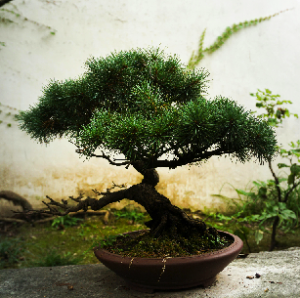Bonsai and Zen
By bonsai4ever.com / October 3, 2025 / No Comments / Bonsai
Bonsai and Zen: A Sacred Connection
The Art of Mindful Cultivation and Spiritual Practice
In the quiet corners of Japanese gardens and meditation halls, an ancient practice bridges the gap between horticulture and spirituality. The art of bonsai, the cultivation of miniature trees, shares an intimate and profound connection with Zen Buddhism, creating a pathway to enlightenment through the patient care of living art.
The Origins of a Sacred Practice
While bonsai as an art form originated in China over a thousand years ago, it was in Japan, deeply influenced by Zen Buddhist philosophy, that it evolved into a meditative practice. Zen monks adopted bonsai cultivation as a form of moving meditation, seeing in the careful pruning and shaping of trees a mirror of their own spiritual discipline and the cultivation of the mind.
The Japanese word “bonsai” itself means “planted in a container,” but this simple translation belies the depth of philosophy contained within the practice. Like Zen, bonsai is not merely about the destination but about the journey—an endless process of refinement, observation, and harmonious interaction with nature.
Mindfulness in Every Branch
At its core, Zen Buddhism emphasizes present-moment awareness, the dissolution of ego, and the direct experience of reality without the interference of conceptual thinking. Bonsai cultivation naturally embodies these principles. When a practitioner works with a bonsai tree, complete attention must be given to each cut, each wire placement, each watering. There is no room for distraction or haste.
The process demands what Zen calls “beginner’s mind”—approaching each tree, each moment, with fresh eyes and without preconceptions. A bonsai artist must observe the tree’s natural tendencies, its unique character, and work with rather than against its inherent nature. This mirrors the Zen teaching of accepting reality as it is, not as we wish it to be.
Patience and Impermanence
Both Zen and bonsai teach profound lessons about time and impermanence. A bonsai tree may take decades to develop, requiring daily attention and seasonal adjustments. The practitioner must embrace patience, understanding that true mastery cannot be rushed. Each day brings subtle changes—a new bud, a shift in foliage color, the slow strengthening of a branch.
This extended timeframe cultivates an awareness of impermanence, a central tenet of Buddhist philosophy. The bonsai artist witnesses the cycles of growth and decay, flourishing and dormancy, life and death. A storm may break a carefully shaped branch; age may transform the tree’s character. These changes are not failures but opportunities to adapt, to find new beauty, to practice non-attachment.
Wabi-Sabi: Finding Beauty in Imperfection
The Zen aesthetic concept of wabi-sabi—finding beauty in imperfection, impermanence, and incompleteness—is fundamental to bonsai art. The most prized bonsai trees often feature deadwood, weathered bark, and asymmetrical forms that echo the harsh beauty of trees shaped by mountain winds or coastal storms.
Rather than seeking artificial perfection, the bonsai artist honors the scars, the twisted trunk, the broken branch that tells a story of survival and resilience. This celebrates the authentic life force of the tree and reminds the practitioner that true beauty emerges from genuine experience, including suffering and struggle.
The Dissolution of Dualities
Zen philosophy teaches the transcendence of dualistic thinking—the artificial separation of self and other, subject and object, artist and artwork. In bonsai cultivation, this teaching manifests as a profound relationship between human and tree. The artist does not dominate the tree but engages in a dialogue with it. The tree’s response to care, its growth patterns, its seasonal expressions all guide the human’s hand.
Over years of cultivation, the boundary between caretaker and tree blurs. The bonsai becomes an extension of the practitioner’s mindfulness practice, while the practitioner becomes attuned to the tree’s needs almost intuitively. This union exemplifies the Zen concept of non-duality, where subject and object merge in the act of pure awareness.
Simplicity and Essential Nature
Zen aesthetics value simplicity, negative space, and the revelation of essential nature. A skilled bonsai artist removes what is unnecessary—excess branches, competing leaders, cluttered foliage—to reveal the tree’s true character. This process of reduction mirrors Zen meditation, where practitioners clear away the mental clutter of thoughts, judgments, and desires to reveal the clear, spacious nature of consciousness itself.
The empty space in a bonsai composition is as important as the tree itself. The Japanese concept of “ma,” or meaningful emptiness, allows the eye and mind to rest, creating balance and inviting contemplation. This negative space is not absence but fullness—the pregnant void from which all forms emerge.
A Living Meditation
For many practitioners, caring for a bonsai becomes a daily meditation practice. The routine of watering, observing, and adjusting creates a ritual that grounds the day in mindfulness. The tree becomes a teacher, offering lessons in patience, acceptance, humility, and presence.
Unlike sitting meditation, which requires stillness, bonsai cultivation is a form of active meditation—what Zen calls “samu,” or mindful work. The hands are busy, but the mind is quiet, focused entirely on the task at hand. In this state, practitioners report experiencing the same expansive awareness and inner peace found in formal meditation practice.
Conclusion: A Path to Awakening
The connection between bonsai and Zen is not merely historical or philosophical—it is experiential and transformative. Through the patient cultivation of these miniature trees, practitioners engage with fundamental truths about existence: the beauty of impermanence, the wisdom of patience, the power of presence, and the unity of all things.
In a world that often values speed, perfection, and control, bonsai and Zen offer an alternative path. They remind us that true mastery comes not from dominating nature but from harmonizing with it, that beauty emerges from authenticity rather than artifice, and that the deepest wisdom is found not in complex theories but in the simple, attentive care of a single living tree.
Whether one approaches bonsai as art, horticulture, or spiritual practice, its connection to Zen offers a profound invitation: to slow down, to observe deeply, to cultivate not just trees but consciousness itself, and to discover in a small pot of soil and branches a mirror of the infinite.
© 2025 – An exploration of mindfulness and nature